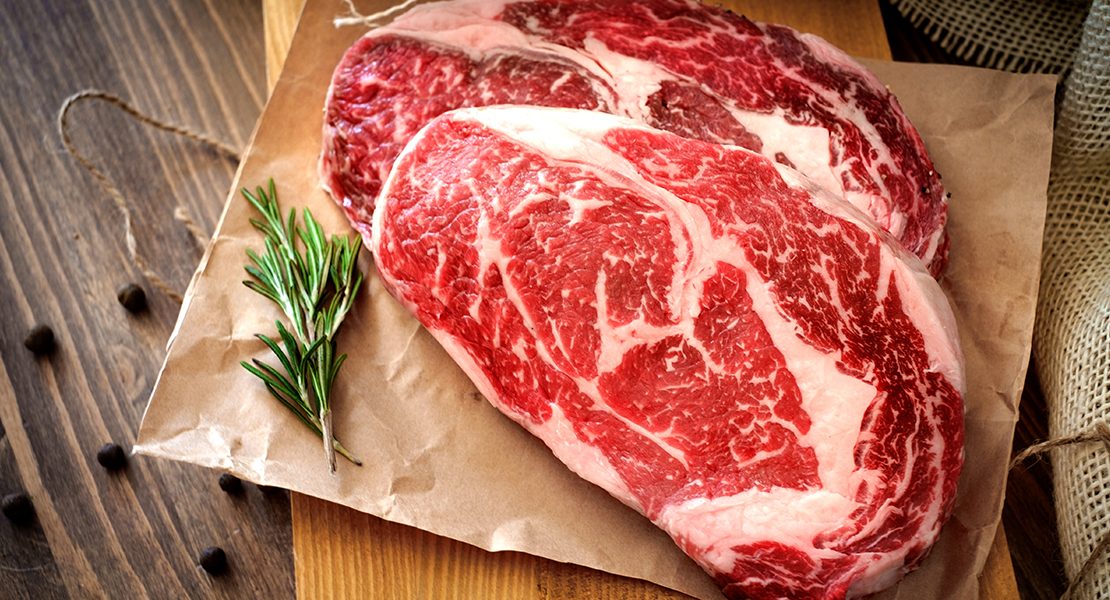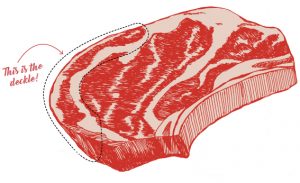What the Heck is Deckle?

Buzz in when you recognize a premium food: Truffles (ding!), caviar (ding!), foie gras (ding!), deckle (silence). Obviously, the unfamiliar deckle of beef could use some image improvement. Even its formal anatomical designation, spinalis dorsi,adds not one scintilla of cachet to the cut. “It’s not a marketable name,” concedes Corporate Chef Christopher Heath of Paxos Restaurants, which includes protein-forward Top Cut Steak House and Blue Grillhouse. “But it’s the most precious part of the ribeye.”
 Also known as the rib cap, the deckle stretches across the top and drapes partway down one side of the “eye” portion of a ribeye steak, delivering the tastiest few bites of the meal. Removing the entire deckle from the primal rib cut produces an inch-or-so-thick rectangle resembling flank steak—and what it lacks in eye-appeal is more than made up for with robustly beefy succulence. The separated rib cap then requires labor-intensive removal of fat, connective tissue, and silverskin prior to being ready for stand-alone consumption. “You may end up with—if you’re lucky—a pound and a half piece of meat that’s set free,” says Chad Smucker, third-generation butcher-owner of Johnny’s Fresh Meats in Allentown. That translates to a total yield of about 3 trimmed pounds from a 1,000-pound on-the-hoof steer.
Also known as the rib cap, the deckle stretches across the top and drapes partway down one side of the “eye” portion of a ribeye steak, delivering the tastiest few bites of the meal. Removing the entire deckle from the primal rib cut produces an inch-or-so-thick rectangle resembling flank steak—and what it lacks in eye-appeal is more than made up for with robustly beefy succulence. The separated rib cap then requires labor-intensive removal of fat, connective tissue, and silverskin prior to being ready for stand-alone consumption. “You may end up with—if you’re lucky—a pound and a half piece of meat that’s set free,” says Chad Smucker, third-generation butcher-owner of Johnny’s Fresh Meats in Allentown. That translates to a total yield of about 3 trimmed pounds from a 1,000-pound on-the-hoof steer.
Expect pricing to reflect rarity. He also adds that the meat is equivalent to beef tenderloin in buttery texture, though beef connoisseurs often prefer the flavor of the robustly marbled rib cap.
Since this delicacy is unlikely to be displayed in local butcher showcases (or appear on area restaurant menus), ordering from an online specialty purveyor offers the easiest option for consumers hankering for a bit of decadence. Varying options include the flat cap (referred to as “Ribeye Crown” by Omaha Steaks), which may be grilled whole to medium rare and sliced at an angle for serving, and rolled, tied, and sliced “American Wagyu” cap steaks from Snake River Farms. Another course of action—and probably the most cost effective—is purchasing a big ol’ subprimal ribeye roll (bones removed), watching deckle-cutting videos on YouTube, and going hands-on with a knife. The remaining “eye” may be sliced into extremely tasty steaks (though not as good as when the deckle remains intact). Consider them a bonus. And consider yourself fortunate to have snagged the unsung star of the steer, deckle.














